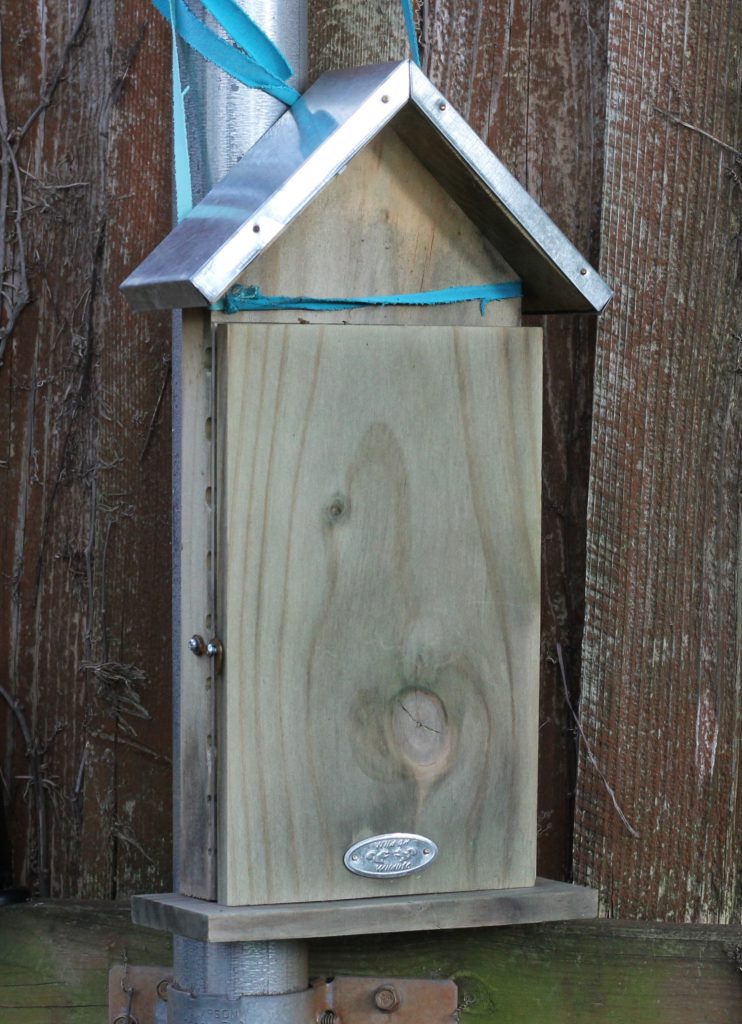I trotted out back to try out a new camera lens this evening because I thought I saw a Dragonfly out there, but it was gone before I got geared up to go. Instead, I wandered over to my solitary bee houses to see what the residents were up to. When I looked last week, there were Leafcutter Bees making their nests and flying back and forth with provisions for their young. This week, some of the tubes had been capped by the chewed vegetation that Leafcutters use. Others had the masonry endcaps other species would use, and some had already been vacated and showed small holes in the center of the endcap.

What really caught my eye though, was the face of a very dark bee peeking out from one of the tubes. I thought maybe it was dead. There are some species of solitary bees that block their nest entrance with their own bodies when they are done laying eggs. It discourages predators from raiding the nest, and the bees actually die at their stations, protecting their young.

I couldn’t see well, but did see one antenna wiggle. Not dead after all! I gently blew on the bee’s face to see if I could get it to move and reveal its species. To my surprise, it got agitated and executed a neat flip and twist inside the tube– to show me nothing but its dark shiny rear end and the back ends of its wings.

Game on. I’ll check on this bee again, and see if I can figure out who’s living there. Add “serial bee harasser” to my list of character flaws. With those sizeable jaws, I’m guessing she’ll turn out to be a Leafcutter of some kind, but bigger than the usual ones here.

I moved on to straighten up the wackily tilted observation bee house and opened it up to see what was happening there. It has a plexiglass cover over a set of routed troughs that bees can nest in. The troughs have different diameters to please different solitary bees, and the whole thing has a hinged wooden cover door to keep the tunnels dark enough for the bees. Several of the tunnels had been used and were vacant already, showing signs of the leftover cell dividers and other detritus. What surprised me was the tiny, lone, live bee in the third tunnel from the bottom.

The hole sizes in this observation box increase toward the top of the box, and this hole was one of the smaller ones. It appeared to be about 3/16” of an inch in diameter. Even with the small tunnel size, this tiny bee had plenty of head room in the tunnel. Bees are full sized when they emerge from their pupal stage, so it wasn’t simply a baby bee. It was a very small adult bee—one I don’t remember seeing in the yard before. It’s possible that it was just seeking shelter for the night, and not even planning to nest there. I could only photograph through the dirty plexiglass, so details are fuzzy. Nevertheless, I think I’ll like this new lens. The result is not so bad at all for being shot through plexiglass in low light.

I haven’t been able to nail down the species just yet, or even whether it’s a male or female. Tomorrow, when the light is better, I might be able to find this bee again and see what it’s doing out there in the landscape. That’s right, I’ll be hunting for a bee that’s barely more than 1/4 inch long. Nobody ever said I was sensible–except my Dad, who might have done the same thing. Meanwhile, I’ll send some pictures to some bee friends and see what they say. Dianthidium? Anthidium? Proanthidium, Paranthidium? Who knows!? All of those bees have cool lifestyle quirks, so whatever it turns out to be, it will be worth investigating.